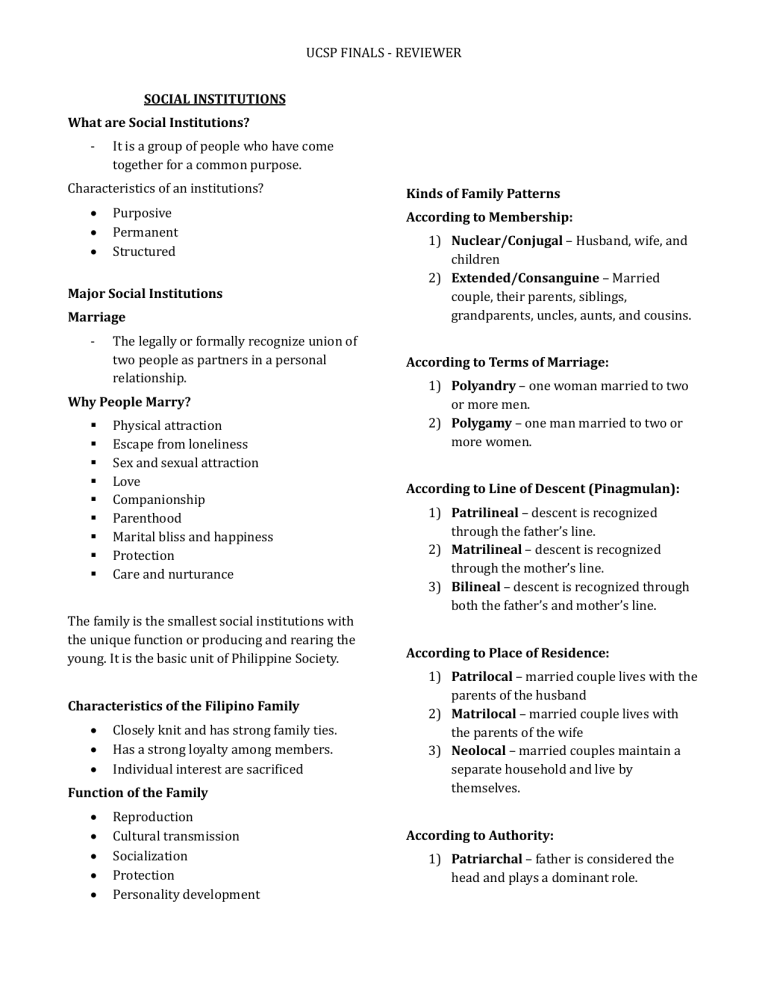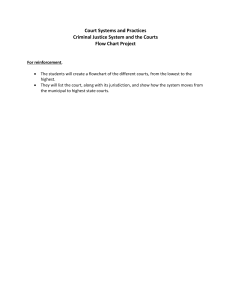
UCSP FINALS - REVIEWER SOCIAL INSTITUTIONS What are Social Institutions? - It is a group of people who have come together for a common purpose. Characteristics of an institutions? • • • Purposive Permanent Structured Major Social Institutions Marriage - The legally or formally recognize union of two people as partners in a personal relationship. Why People Marry? ▪ ▪ ▪ ▪ ▪ ▪ ▪ ▪ ▪ Physical attraction Escape from loneliness Sex and sexual attraction Love Companionship Parenthood Marital bliss and happiness Protection Care and nurturance The family is the smallest social institutions with the unique function or producing and rearing the young. It is the basic unit of Philippine Society. Characteristics of the Filipino Family • • • Closely knit and has strong family ties. Has a strong loyalty among members. Individual interest are sacrificed Function of the Family • • • • • Reproduction Cultural transmission Socialization Protection Personality development Kinds of Family Patterns According to Membership: 1) Nuclear/Conjugal – Husband, wife, and children 2) Extended/Consanguine – Married couple, their parents, siblings, grandparents, uncles, aunts, and cousins. According to Terms of Marriage: 1) Polyandry – one woman married to two or more men. 2) Polygamy – one man married to two or more women. According to Line of Descent (Pinagmulan): 1) Patrilineal – descent is recognized through the father’s line. 2) Matrilineal – descent is recognized through the mother’s line. 3) Bilineal – descent is recognized through both the father’s and mother’s line. According to Place of Residence: 1) Patrilocal – married couple lives with the parents of the husband 2) Matrilocal – married couple lives with the parents of the wife 3) Neolocal – married couples maintain a separate household and live by themselves. According to Authority: 1) Patriarchal – father is considered the head and plays a dominant role. UCSP FINALS - REVIEWER 2) Matriarchal – mother is considered the head and makes the major decisions. 3) Equalitarian – both the mother and the father share in making decisions and are equal in authority. Primary (DEPED) • • Pre-School/Kindergartens Elementary (Grades 1-6) Secondary (DEPED) • • High School (Grades 7 – 10) Senior High School (Grades 11 – 12) Tertiary/Higher Education (CHED) EDUCATION Education (Edukasyon) - The process of receiving or giving systematic instruction especially at a school or university - Hidden Curriculum - - Forms of Education 1) Formal – this is instruction given in schools 2) Informal – individual acquires knowledge skills and vales through everyday experience 3) Non-Formal – education activities that are organized outside the established formal system Functions of Education - Inculcation of values and norms of society Maintenance of perpetuation of cultural heritage Development of skills for preparation in the future Political, economic and social integration Social control Philippine Educational System Bachelor’s / College Degree Master’s Degree Doctorate Degree Refers to unwritten, unofficial, and often unintended lessons/values that students learn in school. Paulo Freire (Cultural of Silence/Cultural Sabotage) Culture of Silence (Positive Examples) - Punctuality Follow instructions. Benefits of working hard Initiative Assignments Talking to your teacher Integration of lesson in real life Lesson learned. Culture of Sabotage - It can contradict the formal curriculum, revealing hypocrisies or inconsistencies between a school’s stated mission, values and what students experience and learn while they are in school. Cultural Perspectives – how schools recognize, integrate or honor diversity may convey both intentional and unintentional message. - English speaking zone UCSP FINALS - REVIEWER - Non-Catholic Students Feelings of Isolation - involves acts of individuals and groups seeking to influence political decisions. Institutional Rules – some schools are very strict in wearing of uniform and some schools have very liberal or permissive clothing policies. Examples: Cultural Sabotage (Negative Examples) Campaign/Advocacy – a series of activities designed to bring about a particular result. - Dealing with problems Relationship with teachers Favoritism Catcalling to students/bullying Too many requirements Punishment (physical and verbal) Integration of lesson in real life Lesson learned. Voting – the official choice that people make in an election. Branches of the Government Executive - - POLITICAL INSTITUTIONS The President of the Philippines administers the Executive Branch of our government. The President enforces the laws that the Legislative Branch (Congress) makes. The President is elected by the Philippines citizens 18 years of age and older, who vote in the presidential elections in their states. Government - Is an institution entrusted with making and enforcing the rules of a society. A group of people who hold a monopoly on the legitimate use of force in a given territory. Executive Power National Government - President Vice-President Cabinet Secretaries Aspects of Politics 1) Power - The ability to impose one’s will over others despite resistance. 2) Legitimacy - The right of political leaders to govern – to hold use and allocate power based on the values a particular society holds. Political Participation Local Government - Judicial Provincial/Regional Governor Provincial/Regional Vice-Governor City/Municipal Mayor City/Municipal Vice-Mayor Barangay Captain UCSP FINALS - REVIEWER - The Judicial part of our federal government include the Supreme Court and 9 Justices. They are special judges who interpret laws according to the Constitution. These justices only hear cases that pertain to issues related to the Constitution. They are the highest court in our country. The federal judicial system also has lower courts located in each state to hear cases involving federal issues. Lower Collegiate Courts - Court of Appeals - Court of Tax Appeals - Sandiganbayan - Representatives meet together to discuss ideas and decide if these ideas (bills) should become laws. Legislative Power National Government - Senate House of Representatives Local Government - Sangguniang Panlalawigan Regional Legislative Assembly Sangguniang Panlungsod Sangguniang Bayan Sangguniang Barangay Regular Courts - Regional Trial Courts Municipal Circuit Trial Courts Muslim Courts - Sharia District Courts Sharia Circuit Courts Office of the Ombudsman – The government and all three of its branches are independently monitored by the office of the Ombudsman. Legislative - The Legislative part of our government is called Congress. Congress makes our laws. Congress is divided into 2 parts. One part is called the Senate. Another part is called House of Representatives. Types of Governments 1) Monarchy - Is a political system in which a representative from one family controls the government and power is passed on through that family from generation to generation. 2) Democracy - Is a political system in which citizens periodically choose officials to run their government. (Rule of the people) 3) Authoritarianism - Is a political system that does not allow citizens to participate in government. 4) Totalitarianism - Is a political system under which the government maintains tight control over nearly all aspects of citizens’ lives. UCSP FINALS - REVIEWER RELIGION AS INSTITUTIONS Religion – the belief in and worship of a superhuman controlling power, especially a personal God or Gods. Church – Islam, Judaism, Hinduism, Christianity Sect – Islam (Sunni at Shia), Judaism (Orthodox at Kraites), Hinduism (Shaktism at Shiyaism), Christianity (Baptist and Lutheranism) Spirituality, religion and Supernatural Monotheism – belief in a single deity Polytheism – belief in many deities Uniting Traditions - When families attend religious services or put-up decorations in honor or a holiday, they are teaching their children about their religion and how to observe it. Beliefs – a feeling of being sure that someone or someone exist. Spirituality – involves deep feelings and beliefs of a religious nature. Rituals – a formal ceremony that is always performed in the same way. Religious Practice - Participation in religious ceremonies may bring a sense of personal lift. It includes rituals, sermons, commemoration, or veneration of saints. Types of Religious Groups 1) Church – a religious group integrated with society. 2) Sect – a group that sets itself apart from society. 3) Cult – an outside standard cultural norm, typically centered around a charismatic leader. 1) Ancestral spirits – human beings are made up of two closely intertwined partners: physical body and spirit body. 2) Animism – the attribution of a soul to plants, inanimate objects, and natural phenomena. 3) Animatism – a belief that a common and impersonal power exists in all living and non-living objects. 4) Folk Catholicism – refers to old beliefs of the people which are interwoven into the catholic practices. 5) Occult – mysterious practices related to supernatural forces beyond the five senses. 6) Shamans – a person who enters an altered state of consciousness to contact and utilize an ordinarily hidden reality. 7) Faith healing – practice of prayer and gestures that are believed by some to elicit divine intervention. 8) Fortune telling – the practice of predicting information about a person’s life. 9) Palmistry – art of analyzing the physical feature of the hands to interpret personality characteristics and predict future. 10) Paranormal events – are purported phenomena whose existence is beyond the scope of normal scientific understanding. 11) Clairvoyance – the claimed ability to gain information about an object, person or physical event through extrasensory perception. UCSP FINALS - REVIEWER Christianity – the most widespread world religion. Islam – followers of Islam are called Muslims where the true word of God was revealed to the prophet Muhammad. Judaism – Jewish people believe in the Torah. Hinduism – the oldest world religion, dominant in India. They believe in the principle of karma. Buddhism – follow the teaching of Siddhartha, Gautama, a spiritual teacher of the sixth century. SOCIAL STRATIFICATION It refers to a society’s categorization of its people into groups based on socioeconomic factors like wealth, income and etc. Concept of Social Stratification 1. Stereotype - Assumes that persons who falls into a particular category on the basis of certain characteristics also have many characteristics that we assume to belong to that category. 2. Self-Fulfilling Prophecy - Once we categorize people through assigning a stereotype, our perception of their behavior is being filtered. 3. Social Comparisons - People need to compare themselves with other in order to establish for themselves what kind of people they are. 4. A Fair World - People are more concerned about establishing equity (just divisions of rewards) than equality (equal divisions of rewards) Equity = fairness Equality = sameness

